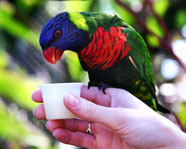
Wild parrots feast on fruit, pollen, nectar, and seeds. That’s why they’ve developed such powerful beaks, which can crack the husk. Its feet have also evolved to pick up large fruits and crush them open. Some parrot species, on the other hand, drink nectar with their very long, brush-tipped tongues.
However, domesticated parrots have different nutritional needs, and most animal experts agree that a pure seed diet is grossly inadequate.
Try to buy fortified seed combinations that are designed to provide different vitamins and minerals. Your veterinarian may recommend a liquid vitamin drop that you can mix into the meal. You should also include pellets, fresh vegetables, and fresh fruits. Parrots will also need a mineral block, which can be hung at the side of the cage. They use this to get trace nutrients that can’t be naturally found in organic foods, and to trim their beak and nails.
It’s important to wash all vegetables thoroughly, to remove any fertilizers and insecticides. Since birds have very efficient metabolisms, they absorb chemicals much faster, and in greater amounts. What’s “perfectly harmless” for humans can make them very, very sick.
You can also buy organic, or grow your own. Parrot enthusiasts also recommend staying away from soy products, since large amounts of this can kill birds. Some say that broccoli, avocado, chocolate, apple seeds and peach pits are also harmful.
Needless to say, don’t feed your parrot too many “human snacks” like chocolate or potato chips. While an occasional sip of soda won’t hurt it, they really don’t need that kind of sugar or fat (come to think of it, neither do you!).
Also minimize the amount of fruits. While they’re technically “healthy’” the high sugar content can soon lead to a very obese and very hyper bird. Lories and lorikeets are the exception, since they are natural nectar eaters.
Parrots Food-Feeding Routines
You will need 3 containers: one for food, one for treats, and another one for water. Fill the dishes early in the morning. Throw away any leftovers at the end of the day. (Pretty soon you’ll be able to gauge how much your bird needs a day.)
It may be hard to convince a seed-fed bird to try other kinds of meals. You can help it get used to its new diet by mixing a small amount of the “new” food into its seeds, until the scent becomes familiar. Over the next few weeks, decrease the amount of seed while offering generous amounts of pellets or vegetables. This forces the parrot to adjust to its new diet (don’t worry, it won’t starve!).